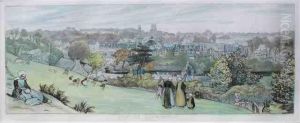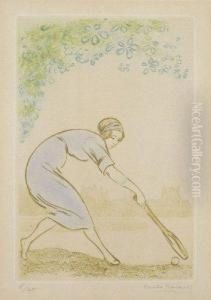Emile A. Malo-Renault Paintings
Émile Alphonse Malo-Renault, born in 1870 in Colombes, France, was a multifaceted artist known for his contributions as a painter, engraver, and illustrator. His artistic journey was heavily influenced by the rich cultural milieu of late 19th and early 20th century France, a period marked by rapid transformations in art and society. Malo-Renault was primarily celebrated for his printmaking skills, particularly in the realm of etching and lithography, which he elevated through his innovative techniques and expressive style.
Educated at the École des Beaux-Arts in Paris, Malo-Renault was deeply engaged with the artistic currents of his time, including Impressionism and Symbolism. However, he carved out a unique niche for himself by blending traditional techniques with a modern sensibility, particularly in his graphic works. His subjects ranged from landscapes and urban scenes to more introspective and symbolic compositions, reflecting a versatile talent that was attuned to the nuances of his environment and the inner workings of the human psyche.
Throughout his career, Malo-Renault was an active participant in the vibrant Parisian art scene. He exhibited his works at various salons and galleries, gaining recognition and accolades from critics and peers alike. His illustrations and prints were also featured in numerous publications, contributing to the visual culture of the era and cementing his reputation as a master printmaker.
Despite his accomplishments, Émile A. Malo-Renault remains a somewhat enigmatic figure in the art historical canon, overshadowed by his contemporaries. Nevertheless, his contributions to the fields of printmaking and illustration are undeniable, and his works continue to be studied and appreciated for their technical mastery and aesthetic beauty.
Malo-Renault's artistry extended beyond his visual creations; he was also known for his writings on art and aesthetics, offering insights into his creative process and the artistic landscape of his time. His legacy is preserved in the collections of various museums and galleries, where his prints and paintings stand as a testament to his skill and vision.
Émile Alphonse Malo-Renault passed away in 1938, leaving behind a body of work that continues to inspire and intrigue art lovers and historians. His life and art embody the spirit of innovation and the quest for beauty that defined his era, making him a significant, if underrecognized, figure in the history of French art.








